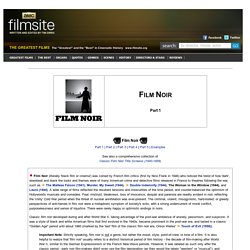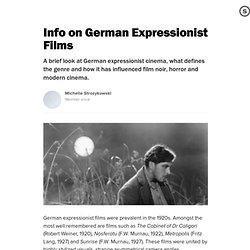

(136) Crash Course Film History Preview. (136) German Expressionism: Crash Course Film History #7. (136) Tim Burton: The Twisted Story Of The Eccentric Filmmaker. (136) TIM BURTON: A Study Of The Strange. (136) TIM BURTON: A Study Of The Strange. Digital Movies : Digital : Works. Top 10 Cinematographers of All Time. Top 10 Cinematographers of All Time. How to shoot a film ALONE! Composition In Storytelling. Opening Shots Tell Us Everything. Top 10 Movie Props of All Time. Top 10 Uses of Silence.
Top 10 Closing Shots of All Time. Top 10 Opening Shots of All Time. How to Start a Short Film Project. Composition + Framing - Storytelling with Cinematography. Storytelling with Cinematography. Storytelling with Cinematography. Visual Storytelling 101. 7 Editing Tips That Are Simple And Beautiful. Ron Howard Teaches Directing. When does the class start?

Ron's class is scheduled to begin in Early 2018. Students who pre-enroll will receive early access to the class. What does the enrollment fee include? Access to every lesson in the class A downloadable workbook with lesson recaps, takeaways, and assignments Membership in an active community of engaged students (upload your own work, or provide feedback to your classmates) Access to instructor feedback and answers in Office Hours You can see more information about what the class includes at masterclass.com/rh What format does the class take?
MasterClass is an immersive online experience. How long is the class? Ron teaches you his approach to directing in 25+ exclusive lessons. Is the class live? Ron’s class includes pre-recorded video lessons, which can be watched at anytime. Can I download the videos? No, the videos are not downloadable - but they are available in your account, ready for viewing (and re-watching) at any time. Will Ron see my work? The Crush 2010 Oscar Winning Short Film. Invention of Love (2010) - Animated Short Film. Paperman - full HD (Original) No Place for a Woman: The Family in Film Noir – A Film Noir Studies Essay. In a disturbing scene from Dark Passage (1947), a back alley plastic surgeon tells Vincent Parry (Humphrey Bogart), "There's no such thing as courage.

There's only fear, the fear of getting hurt and the fear of dying. That's why human beings live so long. " He is looking straight at Parry and — through the use of the subjective camera — straight at the audience. His statement is especially striking because it dismisses courage as a myth soon after World War II, rejecting a basic cultural belief that all of America and all of Hollywood had just spent four years trying to build up. A short description of film noir In classical Hollywood cinema, as in American culture generally, the family and home life are celebrated as a safe haven from the world outside and a common aspiration of each generation.
Experiment with alternative formulas and introduced a radically different visual and narrative style. Still, noir films usually stop short of rejecting the family altogether. Film Noir - Films. Film Noir (literally 'black film or cinema') was coined by French film critics (first by Nino Frank in 1946) who noticed the trend of how 'dark', downbeat and black the looks and themes were of many American crime and detective films released in France to theatres following the war, such as The Maltese Falcon (1941), Murder, My Sweet (1944), Double Indemnity (1944), The Woman in the Window (1944), and Laura (1944).

A wide range of films reflected the resultant tensions and insecurities of the time period, and counter-balanced the optimism of Hollywood's musicals and comedies. Fear, mistrust, bleakness, loss of innocence, despair and paranoia are readily evident in noir, reflecting the 'chilly' Cold War period when the threat of nuclear annihilation was ever-present. Classic film noir developed during and after World War II, taking advantage of the post-war ambience of anxiety, pessimism, and suspicion. Info on German Expressionist Films: The Techniques and Influence of Metropolis, Nosferatu, M and Others. German expressionist films were prevalent in the 1920s.

Amongst the most well remembered are films such as The Cabinet of Dr Caligari (Robert Weiner, 1920), Nosferatu (F.W. Murnau, 1922), Metropolis (Fritz Lang, 1927) and Sunrise (F.W. Murnau, 1927). These films were united by highly stylized visuals, strange asymmetrical camera angles, atmospheric lighting and harsh contrasts between dark and light. Shadows and silhouettes were an important feature of expressionism, to the extent that they were actually painted on to the sets in The Cabinet of Dr Caligari.
German Expressionist Influence on Film Noir. World Film History — Week 3: German Expressionism FTW. World Film History — Week 4 Part 1: Soviet Montage: Eisenstein, Kuleshov, Vertov, and Pudovkin. World Film History — Week 5: French Avant-Garde and Impressionism. A Brief History of Film- Animated Documentary. A Brief History of Filmmaking and How it Affects Viewers - Steven Michael King. A Concise History of the Origins of Cinema.